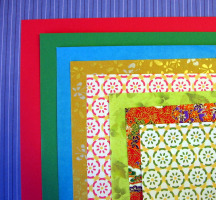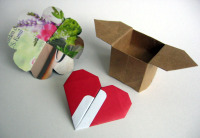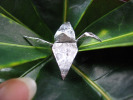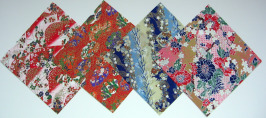|
All About
Origami Paper

Here are five ideas for sources of paper:
• Craft stores
• Web sites (check out our store)
• Specialty artist-supply stores
• Print shops, copy centers, or
office-supply stores
• Around your home
Basic origami paper has color only on one side, is perfectly square, and is thinner than your plain white computer printer paper.
The
most common size is 5 7/8 inches (15 cm). It's often simply called 6-inch paper. This is what we use in most
of our folding instructions. We recommend keeping a good supply on hand
for practicing. A 65-sheet pack is available in our store. Click to go to the store >
The popularity of scrapbooking has been a boon for origami crafters by making readily available a variety of patterned papers, tools, and supplies.
Note:
Some manufacturers label all their products "paper," regardless of the
weight. Be careful not to inadvertently purchase cardstock, which is
too thick for most origami projects.
Craft stores. In
our local big-box craft store, the origami supplies occupy a small
section adjacent to the humongous scrapbooking department. These
stores are good sources of basic paper, but selections of fancier paper
are generally limited.
Web sites. Of course, online shopping has opened up a world of paper sources.
A potential pitfall of buying paper online is that it can be more difficult to know exactly what you’re getting.
Our store has a collection of our favorite papers, carefully selected by our lead origami artist.
Other local stores.
You might prefer to shop at a local artist-supply store, at least until
you’re familiar with origami papers. These stores will often have
a good selection of origami paper in stock.
Here's another
potential advantage of a locally-owned store: Most packets of
origami paper have a sticky flap which you may be able to open (with
the store manager’s approval) to check the consistency of the paper,
and then re-seal.
Print shops, copy centers, and office-supply
stores are sources of color copy paper, which is ideal for some
projects. Our instructions suggest this when appropriate. Phone ahead to be sure you can buy individual sheets!
Your home. You can look aro und
your home and probably find all kinds of suitable paper. The trick will
be getting it perfectly square, or rectangular, depending on the
project, and of an appropriate color and thickness. und
your home and probably find all kinds of suitable paper. The trick will
be getting it perfectly square, or rectangular, depending on the
project, and of an appropriate color and thickness.
Here, we've recycled a brown-paper shopping bag for a candy-dish box, >
a magazine cover for a flower,
and a Netflix wrapper for a heart.
 And save those wrappers from stick gum, especially the foil part. You can make teeny-tiny origami and wow your friends. And save those wrappers from stick gum, especially the foil part. You can make teeny-tiny origami and wow your friends.
<Here's a gum wrapper crane perched like a jewel on a houseplant.
Your computer printer paper is fine for practice (if you can cut it
perfectly square), and some projects, but if you’re a beginner, we
strongly recommend you start with basic origami paper.
Why? It’s
easier to keep track of what you’re doing with paper that’s colored on
one side and white on the other. And, paper that's too thick can split
at the creases and be just plain frustrating to work with.
Understanding Japanese Paper Terms
When you shop for fancier paper, you’ll come across several Japanese terms with a lot of history behind them.
Here’s all you really need to know:
Washi means Japanese-made paper, covering a wide range of patterns and qualities.
The terms Chiyogami and Yuzen are used interchangeably to refer to the design or pattern printed on the paper.
When you see these terms in a product description, you can be assured it’s beautiful paper.
Here's some exquisite paper >
by Aitoh. Kotobuki is another popular brand of extra-special paper.
Some tips on shopping for Japanese paper online:
Be sure the term “origami” is in the description. Otherwise, it may not be the square paper you expect.
Some beautiful Japanese papers are fabric-like in consistency and may not be stiff enough for your project. Have fun exploring the world of paper possibilities!
Return to Basics and Tips from All About Origami Paper
All About Origami Home
|

